
Squalane vs. Hyaluronic Acid: Which One is Better for Your Skin?
In the vast world of skincare, squalane and hyaluronic acid have both risen to prominence as two of the most sought-after ingredients. From serums to moisturizers, face washes, and even eye creams, these two ingredients are hailed as miracle workers when it comes to hydrating the skin. But despite their widespread use, they have distinct characteristics that can make one more suitable than the other depending on your skin’s needs. So, how do you decide which one is better for your skin? Let’s break down the differences, benefits, and optimal ways to incorporate them into your skincare routine.
What is Squalane?
Squalane is a hydrogenated version of squalene, a naturally occurring lipid found in our skin’s sebum. This substance is vital for maintaining healthy skin because it plays a key role in hydration, providing the skin with necessary moisture. However, while squalene itself is incredibly beneficial, it has one major drawback: it is an unstable molecule. That’s where squalane comes in.
Squalane is a more stable, synthetic version of squalene that has been processed for cosmetic use, making it much more durable in skincare formulations. This transformation allows squalane to retain the beneficial properties of squalene while being less prone to oxidation. The stability of squalane makes it an excellent choice for skincare products.
Blair Murphy-Rose, MD, FAAD, a board-certified dermatologist, explains that squalane acts as an emollient, meaning it softens and smoothes the skin’s texture while sealing moisture in. It also helps protect the skin’s barrier and has antioxidant properties that shield the skin from free radical damage, which is often caused by environmental stressors like pollution, UV rays, and harsh weather conditions.
Squalane is particularly helpful for individuals experiencing dry skin, as it mimics the body’s natural oils and replenishes lost moisture. It’s also non-comedogenic, meaning it won’t clog pores, making it safe to use even for people with acne-prone skin. Additionally, squalane is lightweight compared to other oils, making it an excellent option for those looking for hydration without feeling heavy or greasy on the skin.
What is Hyaluronic Acid?
Hyaluronic acid is a naturally occurring substance in the body, primarily found in the skin, eyes, and joints. Its main role is to act as a humectant, a substance that draws moisture from the environment and helps the skin retain it. Hyaluronic acid has the remarkable ability to hold up to 1,000 times its weight in water, making it one of the most hydrating ingredients in skincare.
According to Dr. Rebecca Marcus, a board-certified dermatologist and founder of Maei MD, hyaluronic acid has an immediate plumping effect on the skin. By attracting moisture and binding it to the skin, hyaluronic acid helps reduce the appearance of fine lines and wrinkles, giving the skin a smoother, firmer appearance. As a result, it has become a staple ingredient in hydrating serums, moisturizers, and eye creams.
Hyaluronic acid is particularly known for its ability to hydrate oily and acne-prone skin. Since it doesn’t clog pores and doesn’t add any heavy oils to the skin, it’s a great option for individuals with oily or combination skin types who are looking for a lightweight, non-greasy way to stay hydrated.
Squalane vs. Hyaluronic Acid: The Key Differences
While both squalane and hyaluronic acid offer incredible benefits to the skin, they work in different ways. Let’s explore these differences in detail:
Chemical Composition:
The most significant difference between the two ingredients is their chemical structure. Squalane is a lipid, a fat-based molecule, while hyaluronic acid is a glycosaminoglycan, which is a long chain of sugar molecules. These differences influence how the two ingredients interact with the skin.
Mode of Hydration:
Hyaluronic acid is a humectant, meaning it draws moisture into the skin from the environment. It’s excellent for giving the skin an instant boost of hydration. However, because it pulls moisture from the air, it requires an occlusive agent to lock that moisture in. That’s where squalane comes into play.
Squalane, on the other hand, acts as an emollient, meaning it forms a barrier on the skin to prevent moisture loss. It helps to seal in hydration and protect the skin’s natural moisture.
Skin Types:
Both ingredients are suitable for most skin types, including sensitive skin. However, there are certain skin types that might benefit more from one over the other.
Hyaluronic Acid: Ideal for oily and acne-prone skin because it hydrates without clogging pores or causing breakouts.
Squalane: Best for dry skin because it helps replenish moisture and supports the skin’s barrier function.
Application Frequency:
Both squalane and hyaluronic acid can be used daily. However, since squalane provides a barrier against moisture loss, it’s often used as a final step in a skincare routine (especially in the evening), while hyaluronic acid is often applied earlier in the routine to draw moisture into the skin.
Can Squalane and Hyaluronic Acid Be Used Together?
Yes! In fact, using squalane and hyaluronic acid together can be extremely effective. Since they work in different ways, combining them ensures that your skin gets both an immediate boost of hydration (from hyaluronic acid) and long-lasting moisture retention (from squalane).
Here’s how to use them together:
Layering Order: When using both ingredients, start by applying hyaluronic acid first. Since it’s a humectant, it draws moisture into the skin, which is why it should go on first when the skin is still slightly damp.
Follow with Squalane: After applying hyaluronic acid, follow up with squalane to lock in all the moisture and keep your skin hydrated for hours.
Whether you choose to use two separate products or a single serum that contains both ingredients, layering them in the right order can provide maximum hydration benefits. Additionally, many products on the market are now formulated with both hyaluronic acid and squalane to take advantage of their complementary properties.
Which One Is Better for Your Skin?
The decision to use squalane or hyaluronic acid depends on your skin’s needs:
If you’re dealing with dry skin, squalane might be more beneficial because it will help replenish lost moisture and prevent further dehydration.
If you need instant hydration and are looking to reduce fine lines and plump up the skin, hyaluronic acid is a great option.
If you have sensitive or acne-prone skin, both ingredients are suitable, but you might prefer hyaluronic acid if you’re looking for something light and non-comedogenic.
In most cases, however, combining both ingredients into your routine can give you the best of both worlds: deep hydration and long-lasting moisture retention.
Conclusion: Hydration Heroes for Every Skin Type
Squalane and hyaluronic acid are both incredible skincare ingredients that can hydrate, nourish, and protect your skin. Whether you have dry, oily, sensitive, or combination skin, both ingredients have unique benefits that cater to a wide range of skincare needs.
Ultimately, the choice between the two depends on your individual skin concerns and preferences. If you’re looking for a lightweight, non-greasy moisturizer, hyaluronic acid may be the answer. If you want something more nourishing and protective, squalane might be more suited to your needs.
By understanding how these ingredients work and how they can be incorporated into your routine, you can better address your skin’s hydration needs and achieve a smoother, more radiant complexion. Both ingredients are highly effective on their own but can work even better when used together in the right order for ultimate hydration and protection.


